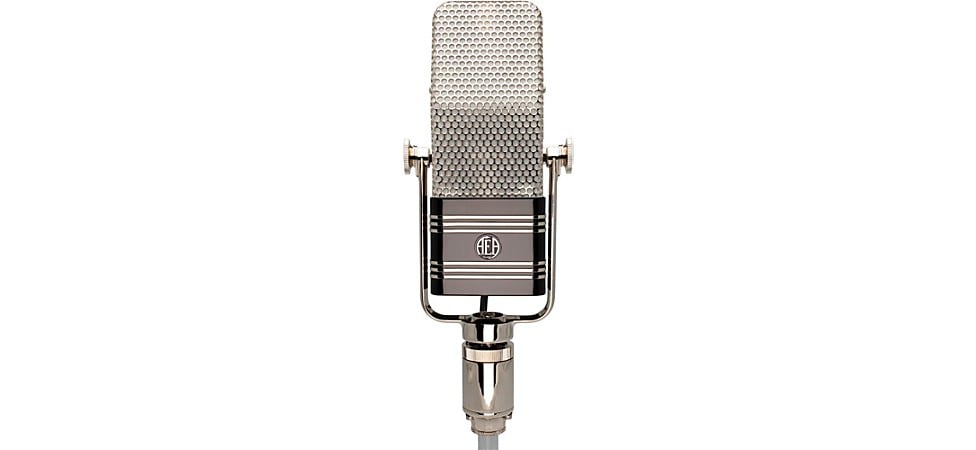In the first article in this series, we took a look at How Dynamic Microphones Work. In this companion article, we’re going to delve into how ribbon mics work and, we’re hopeful, explain why you want both in your mic locker. But first, a quick review.
Microphones, like instrument pickups and loudspeakers, belong to a class of devices known as “transducers.” What every transducer has in common is that they convert one form of energy into another. In all the above cases, that means mechanical and electrical energy. For mics and pickups, it’s converting mechanical energy into electrical energy. For speakers, the conversion is the other direction, from electrical to mechanical energy. Although, because of similarities in construction, you can use a speaker as a microphone, a trick frequently used for so-called “sub-kick” drum mics. But that’s a story for another time. Let’s get back to ribbon microphones.

Pictured: Royer R-121 Ribbon Microphone
If you’ve read the article on dynamic mics we linked above, you will already know about the concept of a pressure-gradient microphone, but here’s a quick refresher. A pressure-gradient mic uses a diaphragm that is open to the air on both sides, which gives it a naturally bi-directional or “figure-of-8” polar pattern. There are two factors of this that are most important to consider. First, because the peaks and valleys (compressions and rarefactions in engineer-speak) of a sound wave cause the microphone’s diaphragm to move in opposite directions, a sound wave’s peak on one side equals a valley on the other, meaning that the two sides of the diaphragm are inherently 180° out of phase with each other. Second, because sounds that come directly from the sides of the microphone cause no difference in pressure between the two sides of the diaphragm, there is essentially no sound picked up from 90° off-axis.
The ribbon microphone falls into the category of pressure-gradient mics, but is sometimes referred to as a velocity microphone. Velocity, in this case, is not referring to the speed of sound, but to “sound particle velocity.” Which raises the question of what, precisely, a “sound particle” is, since there is no sonic equivalent of a photon (light particle). Sound, in fact, as producer Don Was once told us, is just “wiggly air.” Audio engineers and microphone designers use the term sound particle to refer to the localized motion ( Don Was’ “wiggle”) around a very small parcel of the medium (generally air) through which the sound wave is moving. In ways, it’s more of a mental image or a way of thinking about it than an actual thing. But, for a ribbon mic, it’s the sound velocity, rather than the sound pressure, that the mic is “hearing.”

Pictured: beyerdynamic M160 Double Ribbon Microphone
So, just how does this thing work, anyway? Unlike the moving-coil dynamic microphone, a ribbon mic suspends a corrugated ribbon, traditionally a very thin (~0.6 micron), extremely lightweight (0.001 to 0.002 gram) piece of corrugated/pleated foil (traditionally aluminum, but advances in materials science have broadened the range of usable foils) is placed sideways between the two poles of a magnet. The foil responds to the sound velocity, and the vibration of the foil in the magnetic field induces a current that is sent to an internal transformer to be boosted on its way to your mic preamp. The natural impedance of a ribbon is very small, and the signal is very low level, so the internal transformer in the mic is very important, both of boosting the level of the signal and changing the impedance to something your preamp can deal with.
An interesting thing about ribbon mics is that they respond much more like the human ear than a moving-coil dynamic or a condenser mic does, both of which are pressure mics. Ribbons are generally perceived as having a more natural, and generally sonically pleasing, response in a wide variety of applications. So what are those applications?

Pictured: AEA Microphones R44C Bidirectional Big Ribbon Studio Microphone
One of our favorite uses for ribbon mics is to use a pair of them in what’s called a Blumlein pair. Developed by British engineer Alan Blumlein in the early 1930s, the technique involves placing two ribbon mics head to head with their polar patterns at right angles to each other. The overlapping figure-8 patterns create a rich and natural stereo field that’s exceptionally satisfying and almost three-dimensional. But ribbons are also great on vocals, especially voiceover work, and their natural high-end roll-off makes them a great mic for guitar amps, brass and drum overheads.
You may run across mentions of ribbon mics being overly delicate and fragile. That may have been the case 80 years ago, but modern designs and materials have moved well past that, and new ribbon mics from companies like Royer, AEA, sE, beyerdynamic and others are solid and reliable, both in the studio and on the road.




